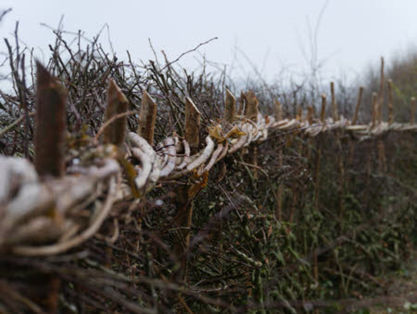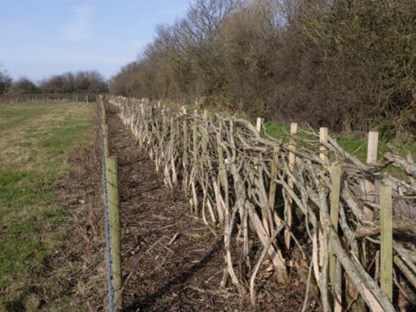There are several different ways to manage a hedgerow. The best way to manage a hedgerow will depend on a number of factors:
- What you want the hedgerow to do i.e. prevent erosion, produce woodchip for energy and/or support biodiversity
- The tree species the hedgerow is made from.
- Local constraints ie roadside regulations, grant schemes or designations
Hedgerows are living and the management of the hedgerow will need to change over a period of decades in order to maintain a hedge in good condition.
This practical guide on hedge row management (Dutch) contains a lot of useful information.
Restoration of existing hedgerows
Hedgerows will naturally decline in condition if they are improperly managed or managed in the same way for long periods of time. These hedgerows will not be maximising the benefits for the farm. It is often quicker and easier to restore the hedgerow rather than remove it and start again.
The first place to start is to survey the hedgerows on you farm to understand the condition and cause of the problem. There are a number of surveying techniques available to use. An example is Hedgelink UK, which is simple to use and has management recommendations for restoring the hedgerow.
Hedgelink - The Hedgerow Management Cycle (English only).
Yearly cutting
Yearly cutting can create a hedgerow with a very dense structure. You may want to consider annual trimming of a hedgerow if the main purpose of the hedgerow is to prevent runoff on the farm.
When annually trimming it is important not to trim to the same size and shape each year or the structure will deteriorate, particularly at the bottom of the hedge, which will reduce prevention of run-off and erosion.
It is essential that the correct species are planted as some species do not respond well to annual cutting. Many species flower and fruit on the second-year growth so annually cutting your hedge significantly reduces the benefits to nature.
Cutting on a two or three year cycle
It is possible to over trim and manage a hedgerow. Cutting a hedgerow on a two or preferably three year cycle has been shown to significantly improve the structure of a hedge.
Hedgerow Management Cycle (English only)
Gradually keep increasing the level of cutting each time by about 10 cm each time to maintain a dense hedge structure. Allowing the hedgerow to become large will increase the productivity benefits to the farm.
This approach has also been found to improve the benefits for nature. Cutting every three years and cutting about 10 cm higher and wider than the previous cut has been found to result in 2-3 times more flowers and berries for overwintering wildlife on hawthorn, blackthorn and bramble.
Relaxed cutting regimes (Agricology) (English only)
Coppicing
Coppicing is the woodland management technique of repeatedly felling trees at the base (or stool), and allowing them to regrow, in order to provide a sustainable supply of timber or woodchip. This practice has a number of benefits over replanting, as the felled trees already have developed root systems, making regrowth quicker and less susceptible to browsing and shading.
It is recommended that coppiced hedgerows are cut on a 5-to-10-year cycle. It is best practice to cut short sections of the hedgerow so that a 100m hedgerow is cut over a several years. This approach maintains habitats for beneficial insects and reduces the impact on the landscape.
Coppicing can also be used to restore hedgerows that are losing their structure because of a lack of management. If a hedge has been coppiced to restore the structure of a hedge it is important to trim the hedge annually for the first five years of regrowth.
Hedge laying
 Laying a hedge is a traditional management practice in the UK. There are many ways to lay a hedge and there are characteristic styles and techniques in each region of the UK. All of the styles have the same benefits though. Hedges are laid to improve the density of the hedge, to fill gaps in the hedge and invigorate new growth in an old hedge.
Laying a hedge is a traditional management practice in the UK. There are many ways to lay a hedge and there are characteristic styles and techniques in each region of the UK. All of the styles have the same benefits though. Hedges are laid to improve the density of the hedge, to fill gaps in the hedge and invigorate new growth in an old hedge.
To lay a hedge, the stem of each plant is cut through almost entirely. Once cut the plants are all laid in the same direction and held in place by wooden stakes. The stakes are then usually bound together to hold them in place.
Hedge laying is a highly skilled, traditional craft with specialist craftspeople employed to complete the work by most land managers.
Hedgelaying: a countryside craft (The countryside charity, English only)
